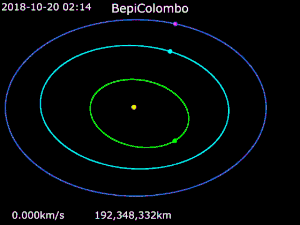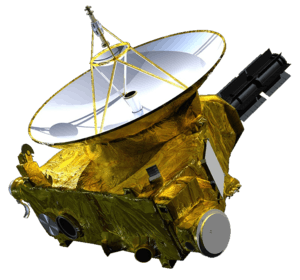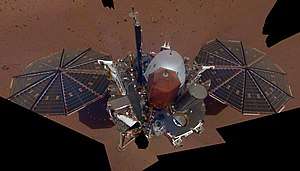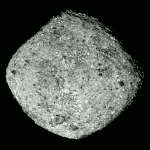BepiColombo
BepiColombo is a joint mission of the European Space Agency (ESA) and the Japan Aerospace Exploration Agency (JAXA) to the planet Mercury.[4] The mission comprises two satellites launched together: the Mercury Planetary Orbiter (MPO) and Mio (Mercury Magnetospheric Orbiter, MMO).[5] The mission will perform a comprehensive study of Mercury, including characterization of its magnetic field, magnetosphere, and both interior and surface structure. It was launched on an Ariane 5[2] rocket on 20 October 2018 at 01:45 UTC, with an arrival at Mercury planned for December 2025, after a flyby of Earth, two flybys of Venus, and six flybys of Mercury.[1][6] The mission was approved in November 2009, after years in proposal and planning as part of the European Space Agency's Horizon 2000+ programme;[7] it is the last mission of the programme to be launched.[8]
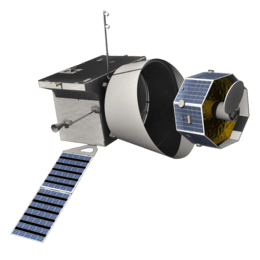 Artist's depiction of the BepiColombo mission, with the Mercury Planetary Orbiter (left) and Mercury Magnetospheric Orbiter (right) | |
| Mission type | Planetary science |
|---|---|
| Operator | ESA · JAXA |
| COSPAR ID | 2018-080A |
| SATCAT no. | 43653 |
| Website | sci global |
| Mission duration | Cruise: 7 years Science phase: 1 year Elapsed: 1 year, 6 months and 6 days |
| Spacecraft properties | |
| Manufacturer | Airbus · ISAS |
| Launch mass | 4,100 kg (9,040 lb)[1] |
| BOL mass | MPO: 1,230 kg (2,710 lb)[1] Mio: 255 kg (560 lb)[1] |
| Dry mass | 2,700 kg (5,950 lb)[1] |
| Dimensions | MPO: 2.4 × 2.2 × 1.7 m[1] (7.9 × 7.2 × 5.6 ft) Mio: 1.8 × 1.1 m[1] (5.9 × 3.6 ft) |
| Power | MPO: 150 W Mio: 90 W |
| Start of mission | |
| Launch date | 20 October 2018, 01:45 UTC |
| Rocket | Ariane 5 ECA[2] |
| Launch site | Centre Spatial Guyanais[3] |
| Contractor | Arianespace |
| Mercury orbiter | |
| Spacecraft component | Mercury Planetary Orbiter (MPO) |
| Orbital insertion | Planned: 5 December 2025 |
| Orbital parameters | |
| Perihermion altitude | 480 km (300 mi) |
| Apohermion altitude | 1,500 km (930 mi) |
| Inclination | 90° |
| Mercury orbiter | |
| Spacecraft component | Mercury Magnetospheric Orbiter (MMO) |
| Orbital insertion | Planned: 5 December 2025 |
| Orbital parameters | |
| Perihermion altitude | 590 km (370 mi) |
| Apohermion altitude | 11,640 km (7,230 mi) |
| Inclination | 90° |
 ESA Solar System insignia for BepiColombo Horizon 2000 Plus | |
Names
BepiColombo is named after Giuseppe "Bepi" Colombo (1920–1984), a scientist, mathematician and engineer at the University of Padua, Italy, who first proposed the interplanetary gravity assist manoeuvre used by the 1974 Mariner 10 mission, a technique now used frequently by planetary probes.
Mio, the name of the Mercury Magnetospheric Orbiter, was selected from thousands of suggestions by the Japanese public. In Japanese, Mio means a waterway, and according to JAXA, it symbolizes the research and development milestones reached thus far, and wishes for safe travel ahead. JAXA said the spacecraft will travel through the solar wind just like a ship traveling through the ocean.[5]
Following its Earth flyby in April 2020, BepiColombo was briefly mistaken for a near-Earth asteroid, receiving the provisional designation 2020 GL2.[9][10][11]
Mission
The mission involves three components, which will separate into independent spacecraft upon arrival at Mercury.[12]
- Mercury Transfer Module (MTM) for propulsion, built by ESA
- Mercury Planetary Orbiter (MPO) built by ESA
- Mercury Magnetospheric Orbiter (MMO) or Mio built by JAXA
During launch and cruise phase, these three components are joined together to form the Mercury Cruise System (MCS).
The prime contractor for ESA is Airbus Defence and Space.[13] ESA is responsible for the overall mission, the design, development assembly and test of the propulsion and MPO modules, and the launch. The two orbiters were successfully launched together on 20 October 2018,[14] on Ariane flight VA245. The spacecraft will have a seven-year interplanetary cruise to Mercury using solar-electric propulsion (ion thrusters) and gravity assists from Earth, Venus and eventual gravity capture at Mercury.[1] ESA's Cebreros 35-metre ground station is planned to be the primary ground facility for communications during all mission phases.
Arriving in Mercury orbit on 5 December 2025, the Mio and MPO satellites will separate and observe Mercury in collaboration for one year, with a possible one-year extension.[1] The orbiters are equipped with scientific instruments provided by various European countries and Japan. The mission will characterize the solid and liquid iron core (3⁄4 of the planet's radius) and determine the size of each.[15] The mission will also complete gravitational and magnetic field mappings. Russia provided gamma ray and neutron spectrometers to verify the existence of water ice in polar craters that are permanently in shadow from the Sun's rays.
Mercury is too small and hot for its gravity to retain any significant atmosphere over long periods of time, but it has a "tenuous surface-bounded exosphere"[16] containing hydrogen, helium, oxygen, sodium, calcium, potassium and other trace elements. Its exosphere is not stable as atoms are continuously lost and replenished from a variety of sources. The mission will study the exosphere composition and dynamics, including generation and escape.
Objectives
The main objectives of the mission are:[3][17]
- Study the origin and evolution of a planet close to its parent star
- Study Mercury's form, interior, structure, geology, composition and craters
- Investigate Mercury's exosphere, composition and dynamics, including generation and escape
- Study Mercury's magnetised envelope (magnetosphere) - structure and dynamics
- Investigate the origin of Mercury's magnetic field
- Verify Einstein's theory of general relativity by measuring the parameters gamma and beta of the parameterized post-Newtonian formalism with high accuracy.[18][19]
Design
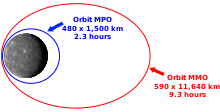
The stacked spacecraft will take seven years to position itself to enter Mercury orbit. During this time it will use solar-electric propulsion and nine gravity assists, flying past the Earth and Moon in April 2020, Venus in 2020 and 2021, and six Mercury flybys between 2021 and 2025.[1]
The stacked spacecraft left Earth with a hyperbolic excess velocity of 3.475 km/s (2.159 mi/s). Initially, the craft is placed in an orbit similar to that of the Earth. After both the spacecraft and the Earth completed one and a half orbits, it returns to Earth to perform a gravity-assist manoeuvre and is deflected towards Venus. Two consecutive Venus flybys reduce the perihelion nearly to Mercury distance with almost no need for thrust. A sequence of six Mercury flybys will lower the relative velocity to 1.76 km/s (1.09 mi/s). After the fourth Mercury flyby, the craft will be in an orbit similar to that of Mercury and will remain in the general vicinity of Mercury (see ). Four final thrust arcs reduce the relative velocity to the point where Mercury will "weakly" capture the spacecraft on 5 December 2025 into polar orbit. Only a small manoeuvre is needed to bring the craft into an orbit around Mercury with an apocentre of 178,000 km. The orbiters then separate and will adjust their orbits using chemical thrusters.[20][21]
Schedule
As of 2018, the planned mission schedule is:[1]
| Date | Event | Comment |
|---|---|---|
| 20 October 2018 | Launch | |
| 10 April 2020 | Earth flyby | 1.5 years after launch |
| 15 October 2020 | First Venus flyby | |
| 11 August 2021 | Second Venus flyby | 1.35 Venus years after first Venus flyby |
| 2 October 2021 | First Mercury flyby | |
| 23 June 2022 | Second Mercury flyby | 2 orbits (3.00 Mercury years) after 1st Mercury flyby |
| 20 June 2023 | Third Mercury flyby | >3 orbits (4.12 Mercury years) after 2nd Mercury flyby |
| 5 September 2024 | Fourth Mercury flyby | ~4 orbits (5.04 Mercury years) after 3rd Mercury flyby |
| 2 December 2024 | Fifth Mercury flyby | 1 orbit (1.00 Mercury year) after 4th Mercury flyby |
| 9 January 2025 | Sixth Mercury flyby | ~0.43 orbits (0.43 Mercury years) after 5th Mercury flyby |
| 5 December 2025 | Mercury orbit insertion | Spacecraft separation; 3.75 Mercury years after 6th Mercury flyby |
| 14 March 2026 | MPO in final science orbit | 1.13 Mercury years after orbit insertion |
| 1 May 2027 | End of nominal mission | 5.82 Mercury years after orbit insertion |
| 1 May 2028 | End of extended mission | 9.98 Mercury years after orbit insertion |


History
The BepiColombo mission proposal was approved in 2000 by the ESA, with a science payload proposal request issued in 2004.[22] In 2007, Astrium was selected as the prime contractor, and the Soyuz-Fregat launcher was dropped in favor of Ariane 5 as the estimated mass increased.[22] The initial target launch of July 2014 was postponed several times, mostly because of delays on the development of the solar electric propulsion.[22] The total cost of the mission is estimated at US$2 billion.[23]
Components
Mercury Transfer Module

| QinetiQ T6 | Performance[24][25] |
|---|---|
| Type | Kaufman Ion Engine |
| Units on board | 4[26][27] |
| Diameter | 22 centimetres (8.7 in) |
| Max. thrust | 145 mN each |
| Specific impulse (Isp) | 4,300 s |
| Propellant | Xenon |
| Total power | 4,628 W |
The Mercury Transfer Module (MTM) is located at the base of the stack. Its role is to carry the two science orbiters to Mercury and to support them during the cruise.
The MTM is equipped with a solar electric propulsion system as the main spacecraft propulsion. Its four QinetiQ T6 ion thrusters operate singly or in pairs for a maximum combined thrust of 290 mN,[28] making it the most powerful ion engine array ever operated in space. The MTM supplies electrical power for the two hibernating orbiters as well as for its solar electric propulsion system thanks to two 14-meter-long solar panels.[29] Depending on the probe's distance to the Sun, the generated power will range between 7 and 14 kW, each T6 requiring between 2.5 and 4.5 kW according to the desired thrust level.
The solar electric propulsion system has typically very high specific impulse and low thrust. This leads to a flight profile with months-long continuous low-thrust braking phases, interrupted by planetary gravity assists, to gradually reduce the velocity of the spacecraft. Moments before Mercury orbit insertion, the MTM will be jettisoned from the spacecraft stack.[29] After separation from the MTM, the MPO will provide Mio all necessary power and data resources until Mio is delivered to its mission orbit; separation of Mio from MPO will be accomplished by spin-ejection.
Mercury Planetary Orbiter
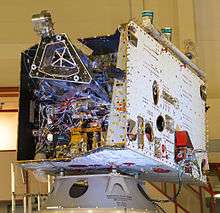
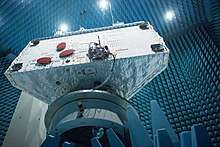
The Mercury Planetary Orbiter (MPO) will have a mass of 1,150 kg (2,540 lb) and will use a single-sided solar array capable of providing up to 1000 watts and featuring Optical Solar Reflectors to keep its temperature below 200 °C (392 °F). The solar array requires continuous rotation keeping the Sun at a low incidence angle in order to generate adequate power while at the same time limiting the temperature.[29]
The MPO will carry a payload of 11 instruments, comprising cameras, spectrometers (IR, UV, X-ray, γ-ray, neutron), a radiometer, a laser altimeter, a magnetometer, particle analysers, a Ka-band transponder, and an accelerometer. The payload components are mounted on the nadir side of the spacecraft to achieve low detector temperatures, apart from the MERTIS and PHEBUS spectrometers located directly at the main radiator to provide a better field of view.[29]
A high-temperature-resistant 1.0 m (3.3 ft) diameter high-gain antenna is mounted on a short boom on the zenith side of the spacecraft. Communications will be on the X and Ka band with an average bit rate of 50 kbit/s and a total data volume of 1550 Gbit/year. ESA's Cebreros 35-metre ground station is planned to be the primary ground facility for communications during all mission phases.[29]
Science payload
The science payload of the Mercury Planetary Orbiter consists of eleven instruments:[30][31]
- BepiColombo Laser Altimeter (BELA), developed by Switzerland and Germany
- Italian Spring Accelerometer (ISA), developed by Italy
- Mercury Magnetometer (MPO-MAG, MERMAG), developed by Germany and UK[29]
- Mercury Radiometer and Thermal Infrared Spectrometer (MERTIS), developed by Germany
- Mercury Gamma-ray and Neutron Spectrometer (MGNS), developed by Russia
- Mercury Imaging X-ray Spectrometer (MIXS), developed by UK and Finland[32]
- Mercury Orbiter Radio-science Experiment (MORE), developed by Italy and the United States
- Probing of Hermean Exosphere by Ultraviolet Spectroscopy (PHEBUS), developed by France and Russia
- Search for Exosphere Refilling and Emitted Neutral Abundances (SERENA),[33] made up of 2 neutral and 2 ionised particle analysers: ELENA (Emitted Low-Energy Neutral Atoms) developed by Italy; STROFIO (STart from a ROtating Field mass spectrOmeter) developed by United States;[34] MIPA (Miniature Ion Precipitation Analyser) developed by Sweden; PICAM (Planetary Ion CAMera) developed by Austria.
- Spectrometers and Imagers for MPO BepiColombo Integrated Observatory System (SIMBIO-SYS), high resolution stereo cameras and a visual and near infrared spectrometer, developed by Italy, France and Switzerland
- Solar Intensity X-ray and Particle Spectrometer (SIXS), developed by Finland and UK
Mio (Mercury Magnetospheric Orbiter)
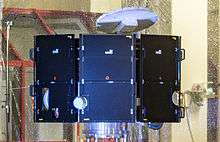
Mio, or the Mercury Magnetospheric Orbiter (MMO), developed and built mostly by Japan, has the shape of a short octagonal prism, 180 cm (71 in) long from face to face and 90 cm (35 in) high.[3][35] It has a mass of 285 kg (628 lb), including a 45 kg (99 lb) scientific payload consisting of 5 instrument groups, 4 for plasma and dust measuring run by investigators from Japan, and one magnetometer from Austria.[3][36][37]
Mio is spin stabilized at 15 rpm with the spin axis perpendicular to the equator of Mercury and it will enter polar orbit at an altitude of 590 × 11,640 km (370 × 7,230 mi), outside of MPO's orbit.[36] The top and bottom of the octagon act as radiators with louvers for active temperature control. The sides are covered with solar cells which provide 90 W. Communications with Earth will be through a 0.8 m (2.6 ft) diameter X band phased array high-gain antenna and two medium-gain antennas operating in the X band. Telemetry will return 160 Gb/year, about 5 kbit/s over the lifetime of the spacecraft, which is expected to be greater than one year. The reaction and control system is based on cold gas thrusters. After its release in Mercury orbit, Mio will be operated by Sagamihara Space Operation Center using Usuda Deep Space Center's 64 m (210 ft) antenna located in Nagano, Japan.[30]
Science payload
Mio carries five groups of science instruments with a total mass of 45 kg (99 lb):[3][30]
- Mercury Plasma Particle Experiment (MPPE), studies the plasma and neutral particles from the planet, its magnetosphere, and the solar wind. It will employ these instruments:
- Mercury Electron Analyzers (MEA1 and MEA2)
- Mercury Ion Analyzer (MIA)
- Mass Spectrum Analyzer (MSA)
- High-Energy Particle instrument for electrons (HEP-ele)
- High-Energy Particle instrument for Ions (HEP-ion)
- Energetic Neutrals Analyzer (ENA)
- Mercury Magnetometer (MMO-MGF), studies Mercury's magnetic field, magnetosphere, and interplanetary solar wind
- Plasma Wave Investigation (PWI), studies the electric field, electromagnetic waves, and radio waves from the magnetosphere and solar wind
- Mercury Sodium Atmosphere Spectral Imager (MSASI), studies the thin sodium atmosphere of Mercury
- Mercury Dust Monitor (MDM), studies dust from the planet and interplanetary space
Mercury Surface Element (cancelled)
The Mercury Surface Element (MSE) was cancelled in 2003 due to budgetary constraints.[8] At the time of cancellation, MSE was meant to be a small, 44 kg (97 lb), lander designed to operate for about one week on the surface of Mercury.[20] Shaped as a 0.9 m (3.0 ft) diameter disc, it was designed to land at a latitude of 85° near the terminator region. Braking manoeuvres would bring the lander to zero velocity at an altitude of 120 m (390 ft) at which point the propulsion unit would be ejected, the airbags inflated, and the module would fall to the surface with a maximum impact velocity of 30 m/s (98 ft/s). Scientific data would be stored onboard and relayed via a cross-dipole UHF antenna to either the MPO or Mio. The MSE would have carried a 7 kg (15 lb) payload consisting of an imaging system (a descent camera and a surface camera), a heat flow and physical properties package, an alpha particle X-ray spectrometer, a magnetometer, a seismometer, a soil penetrating device (mole), and a micro-rover.[38]
Artwork
Like the Hayabusa 2 mission the BepiColombo mission is topic of artwork. The manga artist Masayuki Ishikawa did create a piece featuring the character Mercury from the manga Madowanai Hoshi as well as the BepiColombo spacecraft.[39][40]
See also
- Exploration of Mercury
- MESSENGER – the first spacecraft to orbit Mercury
References
- "BepiColombo Factsheet". European Space Agency. 6 July 2017. Retrieved 6 July 2017.
- "BepiColombo's first image from space". esa.int. 10 October 2018.
- "MIO/BepiColombo". JAXA. 2018. Retrieved 9 July 2018.
- Amos, Jonathan (18 January 2008). "European probe aims for Mercury". BBC News. Retrieved 21 January 2008.
- "MIO - Mercury Magnetospheric Orbiter's New Name" (Press release). JAXA. 8 June 2018. Retrieved 9 June 2018.
- "BepiColombo Launch Rescheduled for October 2018". European Space Agency. 25 November 2016. Retrieved 14 December 2016.
- "BepiColombo Overview". European Space Agency. 5 September 2016. Retrieved 13 March 2017.
- "Critical Decisions on Cosmic Vision" (Press release). European Space Agency. 7 November 2003. No. 75-2003. Retrieved 14 December 2016.
- "MPEC 2020-G96 : 2020 GL2". Minor Planet Center. 13 April 2020. Archived from the original on 13 April 2020.
- "2020 GL2". Minor Planet Center. 13 April 2020. Archived from the original on 13 April 2020.
- "MPEC 2020-G97 : DELETION OF 2020 GL2". Minor Planet Center. 13 April 2020. Retrieved 14 April 2020.
- Hayakawa, Hajime; Maejima, Hironori (2011). BepiColombo Mercury Magnetospheric Orbiter (MMO) (PDF). 9th IAA Low-Cost Planetary Missions Conference. 21–23 June 2011. Laurel, Maryland.
- "BepiColombo to Enter Implementation Phase". European Space Agency. 26 February 2007.
- Amos, Jonathan. "Blast-off for BepiColombo on mission to Mercury". BBC News. Retrieved 20 October 2018.
- Science with BepiColombo. ESA. Accessed: 23 October 2018.
- Domingue, Deborah L.; Koehn, Patrick L.; et al. (August 2007). "Mercury's Atmosphere: A Surface-Bounded Exosphere". Space Science Reviews. 131 (1–4): 161–186. Bibcode:2007SSRv..131..161D. doi:10.1007/s11214-007-9260-9.
- "BepiColombo: Fact Sheet". European Space Agency. 1 December 2016. Retrieved 13 December 2016.
- "BepiColombo - Testing general relativity". European Space Agency. 4 July 2003. Archived from the original on 7 February 2014. Retrieved 7 February 2014.
- Einstein’s general relativity reveals new quirk of Mercury’s orbit. Emily Conover, Science News. 11 April 2018,
- "BepiColombo". National Space Science Data Center. NASA. 26 August 2014. Retrieved 6 April 2015.
- "Mission Operations - Getting to Mercury". European Space Agency. Retrieved 7 February 2014.
- BepiColombo: Joint Mission to Mercury. Elizabeth Howell, Space.com. 21 October 2018.
- BepiColombo Mercury mission tested for journey into 'pizza oven'. Stephen Clarke, Spaceflight Now. 17 July 2017.
- Qualification of the T6 Thruster for BepiColombo. R. A. Lewis, J. Pérez Luna, N. Coombs. 30th International Symposium on Space Technology and Science 34th International Electric Propulsion Conference and 6th Nano-satellite Symposium, Hyogo-Kobe, Japan. 4–10 July 2015.
- QinetiQ’s T6 and T5 Ion Thruster Electric Propulsion System Architectures and Performances. (PDF) Mark Hutchins, Huw Simpson. 30th International Symposium on Space Technology and Science 34th International Electric Propulsion Conference and 6th Nano-satellite Symposium, Hyogo-Kobe, Japan. 4–10 July 2015.
- "T6 ion thruster firing". European Space Agency. 27 April 2016. Retrieved 7 August 2019.
- "T6 ion thrusters installed on BepiColombo". European Space Agency. 26 April 2016. Retrieved 7 August 2019.
- Clark, Stephen D.; Hutchins, Mark S.; et al. (2013). BepiColombo Electric Propulsion Thruster and High Power Electronics Coupling Test Performances. 33rd International Electric Propulsion Conference. 6–10 October 2013. Washington, D.C. IEPC-2013-133.
- "Mercury Planetary Orbiter - Spacecraft". European Space Agency. 16 August 2018. Retrieved 7 August 2019.
- "MMO (Mercury Magnetospheric Orbiter) : Objectives". JAXA. 2011. Retrieved 7 February 2014.
- "Mercury Planetary Orbiter - Instruments". European Space Agency. 15 January 2008. Retrieved 6 February 2014.
- Fraser, G.W.; Carpenter, J.D.; Rothery, D.A.; Pearson, J.F.; Martindale, A.; Huovelin, J.; Treis, J.; Anand, M.; Anttila, M.; Ashcroft, M.; Benkoff, J.; Bland, P.; Bowyer, A.; Bradley, A.; Bridges, J.; Brown, C.; Bulloch, C.; Bunce, E.J.; Christensen, U.; Evans, M.; Fairbend, R.; Feasey, M.; Giannini, F.; Hermann, S.; Hesse, M.; Hilchenbach, M.; Jorden, T.; Joy, K.; Kaipiainen, M.; Kitchingman, I.; Lechner, P.; Lutz, G.; Malkki, A.; Muinonen, K.; Näränen, J.; Portin, P.; Prydderch, M.; Juan, J. San; Sclater, E.; Schyns, E.; Stevenson, T.J.; Strüder, L.; Syrjasuo, M.; Talboys, D.; Thomas, P.; Whitford, C.; Whitehead, S. (2010). "The mercury imaging X-ray spectrometer (MIXS) on bepicolombo". Planetary and Space Science. 58 (1–2): 79–95. doi:10.1016/j.pss.2009.05.004. ISSN 0032-0633.
- "SERENA". European Space Agency. Retrieved 7 August 2019.
- "Strofio". Discovery Program. NASA. Archived from the original on 8 January 2017. Retrieved 7 January 2017.
- Yamakawa, Hiroshi; Ogawa, Hiroyuki; et al. (January 2004). "Current status of the BepiColombo/MMO spacecraft design". Advances in Space Research. 33 (12): 2133–2141. Bibcode:2004AdSpR..33.2133Y. doi:10.1016/S0273-1177(03)00437-X.
- "Mercury Exploration Project "BepiColombo"" (PDF). JAXA. 2014. Retrieved 6 April 2015.
- "A PAIR OF PLANETARY EXPLORERS AT MERCURY". esa.int. Retrieved 21 October 2018.
- "BepiColombo's lander". European Space Agency. 20 February 2002. Retrieved 7 February 2014.
- 石川雅之 (27 July 2018). "元絵は「みお」を追加してプロジェクトにご笑納いただきましたpic.twitter.com/fYhYUT7nif". @isk_ms (in Japanese). Retrieved 9 March 2020.
- "【JAXA╳『惑わない星』】 水星探査機「みお(MIO)」プロジェクトサイエンティストと石川雅之の打ち上げ直前対談が実現!(Google Translate)". translate.google.com. Retrieved 9 March 2020.
External links
- BepiColombo website by the European Space Agency
- BepiColombo Operations website by the European Space Agency
- BepiColombo website by JAXA
- BepiColombo website by JAXA's Institute of Space and Astronautical Science
- BepiColombo website by NASA's Solar System Exploration
- BepiColombo website by the National Space Science Data Center
